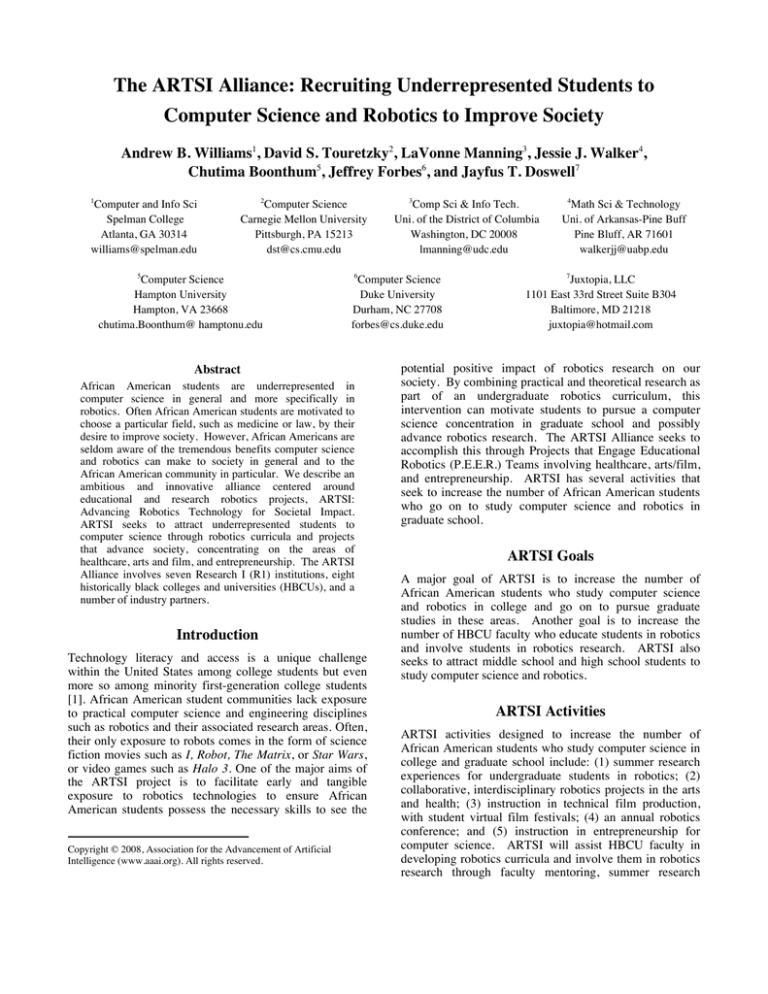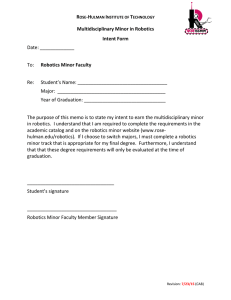
The ARTSI Alliance: Recruiting Underrepresented Students to
Computer Science and Robotics to Improve Society
Andrew B. Williams1, David S. Touretzky2, LaVonne Manning3, Jessie J. Walker4,
Chutima Boonthum5, Jeffrey Forbes6, and Jayfus T. Doswell7
1
Computer and Info Sci
Spelman College
Atlanta, GA 30314
williams@spelman.edu
2
Computer Science
Carnegie Mellon University
Pittsburgh, PA 15213
dst@cs.cmu.edu
5
Computer Science
Hampton University
Hampton, VA 23668
chutima.Boonthum@ hamptonu.edu
6
Comp Sci & Info Tech.
Uni. of the District of Columbia
Washington, DC 20008
lmanning@udc.edu
Computer Science
Duke University
Durham, NC 27708
forbes@cs.duke.edu
Abstract
African American students are underrepresented in
computer science in general and more specifically in
robotics. Often African American students are motivated to
choose a particular field, such as medicine or law, by their
desire to improve society. However, African Americans are
seldom aware of the tremendous benefits computer science
and robotics can make to society in general and to the
African American community in particular. We describe an
ambitious and innovative alliance centered around
educational and research robotics projects, ARTSI:
Advancing Robotics Technology for Societal Impact.
ARTSI seeks to attract underrepresented students to
computer science through robotics curricula and projects
that advance society, concentrating on the areas of
healthcare, arts and film, and entrepreneurship. The ARTSI
Alliance involves seven Research I (R1) institutions, eight
historically black colleges and universities (HBCUs), and a
number of industry partners.
Introduction
Technology literacy and access is a unique challenge
within the United States among college students but even
more so among minority first-generation college students
[1]. African American student communities lack exposure
to practical computer science and engineering disciplines
such as robotics and their associated research areas. Often,
their only exposure to robots comes in the form of science
fiction movies such as I, Robot, The Matrix, or Star Wars,
or video games such as Halo 3. One of the major aims of
the ARTSI project is to facilitate early and tangible
exposure to robotics technologies to ensure African
American students possess the necessary skills to see the
Copyright © 2008, Association for the Advancement of Artificial
Intelligence (www.aaai.org). All rights reserved.
3
4
Math Sci & Technology
Uni. of Arkansas-Pine Buff
Pine Bluff, AR 71601
walkerjj@uabp.edu
7
Juxtopia, LLC
1101 East 33rd Street Suite B304
Baltimore, MD 21218
juxtopia@hotmail.com
potential positive impact of robotics research on our
society. By combining practical and theoretical research as
part of an undergraduate robotics curriculum, this
intervention can motivate students to pursue a computer
science concentration in graduate school and possibly
advance robotics research. The ARTSI Alliance seeks to
accomplish this through Projects that Engage Educational
Robotics (P.E.E.R.) Teams involving healthcare, arts/film,
and entrepreneurship. ARTSI has several activities that
seek to increase the number of African American students
who go on to study computer science and robotics in
graduate school.
ARTSI Goals
A major goal of ARTSI is to increase the number of
African American students who study computer science
and robotics in college and go on to pursue graduate
studies in these areas. Another goal is to increase the
number of HBCU faculty who educate students in robotics
and involve students in robotics research. ARTSI also
seeks to attract middle school and high school students to
study computer science and robotics.
ARTSI Activities
ARTSI activities designed to increase the number of
African American students who study computer science in
college and graduate school include: (1) summer research
experiences for undergraduate students in robotics; (2)
collaborative, interdisciplinary robotics projects in the arts
and health; (3) instruction in technical film production,
with student virtual film festivals; (4) an annual robotics
conference; and (5) instruction in entrepreneurship for
computer science. ARTSI will assist HBCU faculty in
developing robotics curricula and involve them in robotics
research through faculty mentoring, summer research
experiences for underrepresented faculty at R1 robotics
labs, robotics summer faculty workshops, and development
and dissemination of robotics educational material through
a web-based portal. The alliance will reach out to the
larger community to encourage middle school and high
school students to study computer science and robotics in
college, through activities such as K-12 community
activities using robotics and art, robotics roadshows for
high school students and teachers, and a robotics
educational film online repository. ARTSI will be an
available resource for K-12 teachers who wish to develop
robotics projects in their schools. High schools will be
encouraged to collaborate with an ARTSI HBCU to
organize robotics clubs or workshops. These partnerships
can result in the high school participating in a robotics
competition such as FIRST robotics.
As an example of an HBCU contribution to ARTSI, the
University of Arkansas at Pine Bluff (UAPB), has
developed an introductory program to introduce students
within computer science to tangible artificial intelligence
artifacts such as robots, software agents, and knowledge
mining applications. The program is designed to provide
students with a basic understanding of the field of artificial
intelligence and the specialization of robotics. The program
not only increases the student’s knowledge of robotics
technology but also helps to eliminate their deficiencies
with respect to practical computer science research and
broadens their understanding of how computer science
concepts can be used to solve real-world problems (Nelson
et al. 2001).
The R1 partners contribute to ARTSI in three ways. (1)
The faculty summer workshop program introduces HBCU
faculty to new platforms and curriculum materials they can
use in their classrooms. (2) A summer REU (Research
Experience for Undergraduates) program brings HBCU
students to R1 labs to work with faculty and graduate
students. (3) R1 faculty can participate as advisors in
P.E.E.R. Team projects to maintain an ongoing working
relationship with HBCU faculty and students.
Cognitive Robotics
A key component of ARTSI’s educational approach is an
emphasis on high level robot programming which we call
“cognitive Robotics”. Cognitive robotics seeks to develop
primitives for perception and manipulation that draw
inspiration from ideas in cognitive science. Rather than
writing simple reactive programs that input raw sensor
values and respond by turning motors on and off, students
are provided with primitives for vision (shape recognition ,
perspective transforms), map building, localization, and
navigation (Touretzky et al. 2007). They can use these
primitives to solve more complex and interesting problems
than would otherwise be possible.
An undergraduate curriculum in cognitive robotics
developed by Touretzky and Tira-Thompson at Carnegie
Mellon has been used at several ARTSI Alliance schools.
The curriculum is based on a software development
framework for mobile robots called Tekkotsu, available for
free at Tekkotsu.org. Tekkotsu was originally created for
the Sony AIBO, but has since been extended to support a
variety of different platforms (Tira-Thompson et al., in
press). Spelman’s robot soccer team, the SpelBots, has
used Tekkotsu to compete in several RoboCup events.
ARTSI Alliance Members and Partners
The current investigators in ARTSI include Andrew B.
Williams, Spelman College; David Touretzky and Illah
Nourbakhsh, Carnegie Mellon; LaVonne Manning, UDC;
Thorna Humphries and Mona Rizvi, Norfolk State
University; Ayanna Howard and Carl DiSalvo, Georgia
Tech; Dieter Fox, University of Washington; Clement
Allen, Florida A&M; Jeffrey Forbes, Duke University;
Chutima Boonthum and Solomon Isekeije, Hampton
University; Keith Hargrove, Morgan State University; Elva
Jones and Rebecca Caldwell, Winston-Salem State
University; Jessie Walker, University of Arkansas-Pine
Bluff; Chad Jenkins, Brown University; and Monica
Anderson, University of Alabama. Industry Partners
include Juxtopia, iRobot, Seagate, and Microsoft Research.
Academic partners include the Center for Healthcare
Robotics, the Quality of Life Technology (QoLT) Center,
The Florida-Georgia Louis Stokes Alliance for Minority
Participation, and the Computer Science Teachers
Association.
Acknowledgements
This work is supported by NSF Broadening Participation in
Computing grants 0742074, 0742075, 0742082, 0742086,
0742089, 0742098, 0742101, 0742106, 0742123, 0742150,
0742156, 0742197, 0742198, and 0742252.
References
ARTSI: Advancing Robotics Technology for Societal
Impact, http://www.artsialliance.org.
Burke, R.J., and Mattis, M.C. eds. 2007. Women and
minorities in science, technology, engineering and
mathematics: upping the numbers. Cheltenham: Edward
Elgar. xviii, 379 p.
Nelson, A., Tu, T.L.N., and Hines, A.H. eds. 2001.
Technicolor: race, technology and everyday life. New
York: New York University Press. viii, 205 p.
Tekkotsu, http://www.tekkotsu.org.
Tira-Thompson, E. J., Nickens, G. V., and Touretzky, D. S.
2007. Extending Tekkotsu to new platforms for cognitive
robotics. In Proceedings of the AAAI-07 Mobile Robots
Workshop. Forthcoming.
Touretzky, D.S., Halelamien, N.S., Tira-Thompson, E.J.,
Wales, J.J., and Usui, K. 2007. Dual-coding
representations for robot vision in Tekkotsu. Autonomous
Robots 22(4):425-435.

